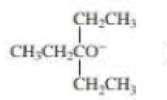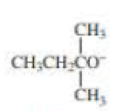
EBK ORGANIC CHEMISTRY
7th Edition
ISBN: 9780133556186
Author: Bruice
Publisher: VST
expand_more
expand_more
format_list_bulleted
Concept explainers
Textbook Question
Chapter 10, Problem 48P
When 2-bromo-2,3-dimethylbutane reacts with a strong base, two
- a. Which of the bases (A, B, C, or D) would form the highest percentage of the highest percentage of the 1-alkene?
- b. Which would give the highest percentage of the 2-alkene?


- A. CH3CH2O–

Expert Solution & Answer
Want to see the full answer?
Check out a sample textbook solution
Students have asked these similar questions
Draw the following molecule: (Z)-1-chloro-1-butene
Identify the molecule as having a(n) E, Z, cis, or trans configuration.
CH3
H₁₂C
○ E
○ z
○ cis
trans
Identify the molecule as having a(n) E, Z, cis, or trans configuration.
H₂C-
CH3
О Е
○ cis
○ trans
Chapter 10 Solutions
EBK ORGANIC CHEMISTRY
Ch. 10.2 - Prob. 1PCh. 10.2 - Prob. 2PCh. 10.2 - Prob. 3PCh. 10.2 - Prob. 4PCh. 10.3 - Four alkenes are formed from the E1 reaction of...Ch. 10.3 - If 2-fluoropentane could undergo an E1 reaction,...Ch. 10.3 - Prob. 7PCh. 10.3 - Propose a mechanism for the following reaction:Ch. 10.4 - Prob. 9PCh. 10.4 - What products will be obtained from the El...
Ch. 10.4 - Prob. 11PCh. 10.5 - Prob. 12PCh. 10.6 - Prob. 14PCh. 10.7 - Why do cis-1-bromo-2-ethylcyclohexane and...Ch. 10.7 - Which isomer reacts more rapidly in an E2...Ch. 10.7 - Prob. 18PCh. 10.8 - Prob. 19PCh. 10.8 - Prob. 20PCh. 10.9 - Prob. 21PCh. 10.9 - Explain why only a substitution product and no...Ch. 10.9 - Prob. 23PCh. 10.9 - Prob. 24PCh. 10.9 - Prob. 25PCh. 10.9 - a. Explain why 1-bromo-2,2-dimethylpropane has...Ch. 10.10 - A small amount of another organic product is...Ch. 10.10 - What is the best way to prepare the following...Ch. 10.10 - Prob. 29PCh. 10.10 - Prob. 30PCh. 10.10 - Why is a cumulated diene not formed in the...Ch. 10.10 - What product is obtained when the following...Ch. 10.11 - Prob. 33PCh. 10.11 - Prob. 34PCh. 10 - Draw the major product obtained when each of the...Ch. 10 - Prob. 36PCh. 10 - a. Indicate how each of the following factors...Ch. 10 - Prob. 38PCh. 10 - A chemist wanted to synthesize the...Ch. 10 - Prob. 40PCh. 10 - Prob. 41PCh. 10 - Prob. 42PCh. 10 - Starting with an alkyl halide, how could the...Ch. 10 - Indicate which species in each pair gives a higher...Ch. 10 - Prob. 45PCh. 10 - For each of the following alkyl halides, indicate...Ch. 10 - Prob. 47PCh. 10 - When 2-bromo-2,3-dimethylbutane reacts with a...Ch. 10 - Prob. 49PCh. 10 - When the following compound undergoes solvolysis...Ch. 10 - cis-1-Bromo-4-tert-butylcyclohexane and...Ch. 10 - Draw the substitution and elimination products.Ch. 10 - Prob. 53PCh. 10 - Prob. 54PCh. 10 - Which of the following hexachlorocyclohexanes is...Ch. 10 - Explain why the rate of the reaction of...Ch. 10 - Prob. 57PCh. 10 - Two elimination products are obtained from the...Ch. 10 - Draw the structures or the product of the obtained...Ch. 10 - How could you prepare the following compounds from...Ch. 10 - cis-4-Bromocyclohexanol and...Ch. 10 - Prob. 62PCh. 10 - Prob. 63P
Knowledge Booster
Learn more about
Need a deep-dive on the concept behind this application? Look no further. Learn more about this topic, chemistry and related others by exploring similar questions and additional content below.Similar questions
- The decomposition of dinitrogen pentoxide according to the equation: 50°C 2 N2O5(g) 4 NO2(g) + O2(g) follows first-order kinetics with a rate constant of 0.0065 s-1. If the initial concentration of N2O5 is 0.275 M, determine: the final concentration of N2O5 after 180 seconds. ...arrow_forwardDon't used hand raitingarrow_forwardCS2(g) →CS(g) + S(g) The rate law is Rate = k[CS2] where k = 1.6 × 10−6 s−¹. S What is the concentration of CS2 after 5 hours if the initial concentration is 0.25 M?arrow_forward
- CS2(g) → CS(g) + S(g) The rate law is Rate = k [CS2] where k = 1.6 × 10-6 s−1. S Calculate the half-life.arrow_forwardThe following is a first order reaction where the rate constant, k, is 6.29 x 10-3 min-*** What is the half-life? C2H4 C2H2 + H2arrow_forwardControl Chart Drawing Assignment The table below provides the number of alignment errors observed during the final inspection of a certain model of airplane. Calculate the central, upper, and lower control limits for the c-chart and draw the chart precisely on the graph sheet provided (based on 3-sigma limits). Your chart should include a line for each of the control limits (UCL, CL, and LCL) and the points for each observation. Number the x-axis 1 through 25 and evenly space the numbering for the y-axis. Connect the points by drawing a line as well. Label each line drawn. Airplane Number Number of alignment errors 201 7 202 6 203 6 204 7 205 4 206 7 207 8 208 12 209 9 210 9 211 8 212 5 213 5 214 9 215 8 216 15 217 6 218 4 219 13 220 7 221 8 222 15 223 6 224 6 225 10arrow_forward
- Collagen is used to date artifacts. It has a rate constant = 1.20 x 10-4 /years. What is the half life of collagen?arrow_forwardיווי 10 20 30 40 50 60 70 3.5 3 2.5 2 1.5 1 [ppm] 3.5 3 2.5 2 1.5 1 6 [ppm] 1 1.5 -2.5 3.5arrow_forward2H2S(g)+3O2(g)→2SO2(g)+2H2O(g) A 1.2mol sample of H2S(g) is combined with excess O2(g), and the reaction goes to completion. Question Which of the following predicts the theoretical yield of SO2(g) from the reaction? Responses 1.2 g Answer A: 1.2 grams A 41 g Answer B: 41 grams B 77 g Answer C: 77 grams C 154 g Answer D: 154 grams Darrow_forward
- Part VII. Below are the 'HNMR, 13 C-NMR, COSY 2D- NMR, and HSQC 2D-NMR (similar with HETCOR but axes are reversed) spectra of an organic compound with molecular formula C6H1003 - Assign chemical shift values to the H and c atoms of the compound. Find the structure. Show complete solutions. Predicted 1H NMR Spectrum 4.7 4.6 4.5 4.4 4.3 4.2 4.1 4.0 3.9 3.8 3.7 3.6 3.5 3.4 3.3 3.2 3.1 3.0 2.9 2.8 2.7 2.6 2.5 2.4 2.3 2.2 2.1 2.0 1.9 1.8 1.7 1.6 1.5 1.4 1.3 1.2 1.1 f1 (ppm) Predicted 13C NMR Spectrum 100 f1 (ppm) 30 220 210 200 190 180 170 160 150 140 130 120 110 90 80 70 -26 60 50 40 46 30 20 115 10 1.0 0.9 0.8 0 -10arrow_forwardQ: Arrange BCC and Fec metals, in sequence from the Fable (Dr. R's slides) and Calculate Volume and Density. Aa BCC V 52 5 SFCCarrow_forwardNonearrow_forward
arrow_back_ios
SEE MORE QUESTIONS
arrow_forward_ios
Recommended textbooks for you
 Organic ChemistryChemistryISBN:9781305580350Author:William H. Brown, Brent L. Iverson, Eric Anslyn, Christopher S. FootePublisher:Cengage Learning
Organic ChemistryChemistryISBN:9781305580350Author:William H. Brown, Brent L. Iverson, Eric Anslyn, Christopher S. FootePublisher:Cengage Learning

Organic Chemistry
Chemistry
ISBN:9781305580350
Author:William H. Brown, Brent L. Iverson, Eric Anslyn, Christopher S. Foote
Publisher:Cengage Learning
How to Design a Total Synthesis; Author: Chemistry Unleashed;https://www.youtube.com/watch?v=9jRfAJJO7mM;License: Standard YouTube License, CC-BY